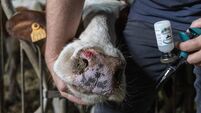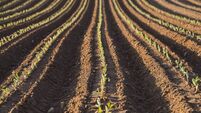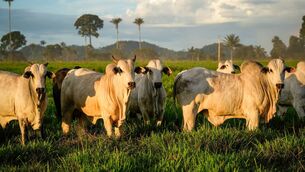Weather not ideal for livestock lately

Obviously, the price being paid by the factories is very disappointing; however, finishing them efficiently is the best way of making any return.
Weather has not been ideal for any livestock lately, but many are now seeing their bulls in particular going backwards. These bulls are losing flesh off their backs, because they can’t consume enough dry matter for maintenance — never mind thriving.
If herd owners want their cattle to finish at target weight, target age and target grade, then they must gain substantial weight every day of their lives. Setbacks in thrive should be avoided, at all costs. You must take maximum advantage of the hormonal effect of young bulls to optimise profit, through their efficient feed conversion efficiency.
What now for these bulls? With many farms finding grassland hard to manage these days, it is likely that for most, the option of feeding bulls meal at grass is a difficult one to implement. Firstly, the paddocks the bulls are in must be dry, to minimise damage.
The right feeding facilities must be available, to avoid injury to both man and bull. Use sturdy troughs, and if using ad-lib feeders, ensure they are bird-proof. For many, the easiest option may in fact be to bring them inside and start finishing them. But is holding on to them the best option?
# How much will they cost to feed?
# How much are they currently worth?
# Will they leave a profit margin? (Depends on price, thrive and weight!).
# Will you be able to get them killed when they are finished?
# And what decisions need to be made, once you have bulls in the shed?
# Are they grown well enough to start finishing?
# What is your target market (weight, age, and grade)?
# Are your facilities suitable for the feeding programme you have in mind?
# What feeds are available to you, and what will they cost?
#What is the quality of the forage available?
It is critical that bulls don’t commence finishing until they have been grown correctly. If they are not grown properly, they may begin a growth spurt during the finishing period, resulting in poor conformation and kill-out percentage. All of the above factors also need to be considered in the context of what type of bull you have on your farm. Continental types will have different maturity characteristics to dairy-bred bulls. In fact, in the final finishing phase, a larger percentage of thrive from continental bulls will be converted to actual carcass sold at slaughter.
AD-LIB
Ad-lib feeding of concentrates may be a more economical option for bull finishers if only poor silages are available. Many get confused with the term ad-lib. For me, it is simple; the cattle must have 24-7 access to meal. They must also have access to good quality clean straw at all times. Hay is a poor substitute for straw, because it does not promote optimum rumen function, and therefore depresses intakes and ultimate weight gains in bulls.
WATER
Water quality is also a critical element to get right when you step up feeding for bulls.
ENVIRONMENT
It may be obvious. But do your cattle have enough space in the shed to achieve optimum performance. Can they all lie down and can they get to their feed without having to walk all over their comrades? Make sure ventilation is adequate also.
# Independent dairy and beef nutrition consultant Brian Reidy, Premier Farm Nutrition, can be contacted at brian@pfn.ie









